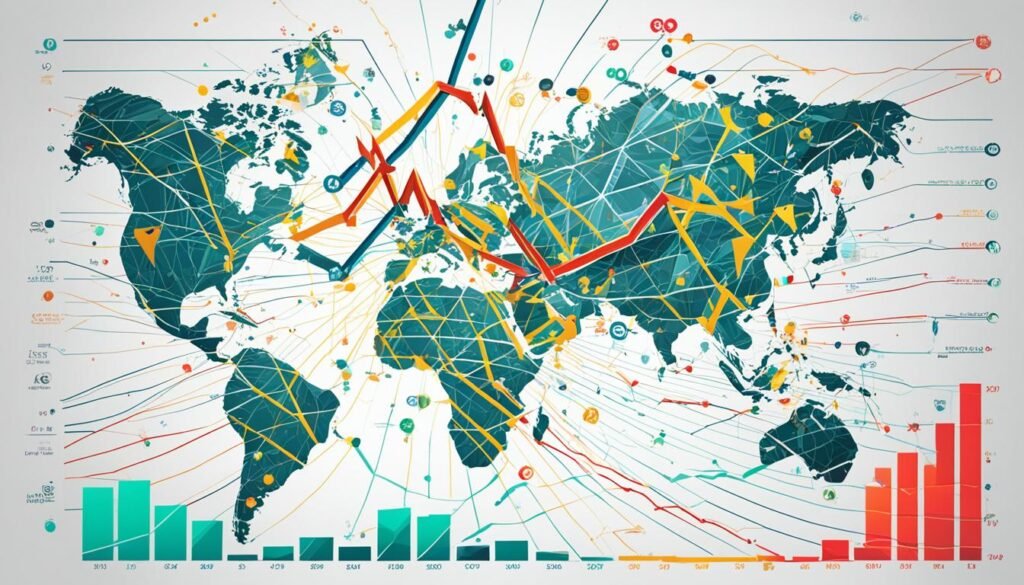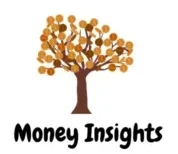Forex trading, also known as FX trading or currency trading, is the act of buying one currency while selling another to profit. The global forex market, valued at a staggering $7.5 trillion daily as of April 2022, stands as the most liquid and largest financial market globally. Thanks to technological progress, online currency trading is now within reach for a wider audience, drawing in new traders. This forex guide aims to simplify the complexities of currency exchange, equipping you with the knowledge to make informed decisions and manage risks effectively in this dynamic field.
Key Takeaways
- Forex trading involves buying and selling currencies to make a profit.
- The global forex market trades around $7.5 trillion daily.
- Online currency trading is accessible to individual traders due to technological advancements.
- Understanding the market helps in making informed trading decisions and managing risks.
- This guide aims to demystify forex trading complexities.
Introduction to Forex Trading
Imagine trading currencies from across the globe, 24/7, five days a week. This is the world of the foreign exchange market, known as Forex or FX. It’s where traders bet on currency price changes, engaging in global currency trading.
What is Forex?
Forex is where national currencies are traded in pairs, like EUR/USD. It’s an electronic market operating over-the-counter (OTC), connecting traders globally around the clock, except on weekends.
Trading forex pairs means buying one currency while selling another. Companies like Charles Schwab Futures and Forex LLC offer services for these trades, making entry easy. The aim is to profit from currency pair movements.
How Forex Markets Operate
Forex trading happens in OTC markets, directly between two parties without a central exchange. Electronic platforms connect a global network of banks, institutions, brokers, and traders.
The market’s daily volume is a massive $7.5 trillion, with the spot market accounting for $2 trillion. Having a brokerage account approved for forex trading is essential. Knowing the dynamics of currency pairs like AUD/USD or EUR/GBP is crucial for participants.
Importance of Forex Trading
Forex trading is crucial for several reasons. It helps hedge against currency and interest rate risks, diversifies portfolios, and speculates on geopolitical events. Historically, institutional firms and banks led the market, but retail traders now play a big part, making up 3-5% of daily volumes.
The foreign exchange market is the largest and most liquid financial market, operating 24/7. It facilitates the electronic trading of global currencies. Understanding its basics, like supply and demand dynamics, is key for forex trading newcomers.
Understanding Currency Pairs
In the realm of forex trading, understanding currency pairs is vital. These pairs consist of a base currency and a quote currency, traded together. The market operates around the clock, five days a week, offering traders numerous opportunities to trade currency pairs.
Major vs. Minor Pairs
Forex market currency pairs are mainly classified as major or minor. Major currency pairs include EUR/USD, USD/JPY, GBP/USD, USD/CHF, AUD/USD, and USD/CAD. These pairs are favored for their high liquidity and large trading volumes. The EUR/USD pair is the most liquid globally, with the USD/JPY close behind.
On the other hand, minor currency pairs, or crosses, do not involve the U.S. dollar. Examples include EUR/GBP, GBP/JPY, and EUR/CHF. These pairs are less liquid but still offer significant trading opportunities.
How to Read Currency Pairs
Understanding currency pairs is simple once you grasp the basics. A pair consists of a base currency followed by a quote currency. The exchange rate indicates how much of the quote currency is required to buy one unit of the base currency. For instance, in EUR/USD, the EUR is the base, and the USD is the quote. An exchange rate of 1.20 means you need 1.20 U.S. dollars to buy one euro.
Examples of Currency Pairs
Examples help illustrate how currency pairs work in the forex market. Major currency pairs like EUR/USD and USD/JPY are highly traded due to their liquidity. Cross-currency pairs, such as EUR/GBP and GBP/JPY, involve major currencies excluding the U.S. dollar. Exotic pairs like USD/SGD include currencies from emerging markets, offering diverse trading options.
Summarizing, grasping the basics of currency pairs is essential for forex traders. Distinguishing between major and minor pairs and understanding exchange rates empowers traders to confidently navigate the forex market.
The Role of Central Banks in Forex Markets
The forex market, with a daily trading volume of $6.6 trillion, is heavily impacted by central banks. These institutions play a pivotal role in shaping the financial landscape. They do this through their monetary policies, interest rate adjustments, and occasional interventions.
Monetary Policies
Central banks, like the U.S. Federal Reserve, the European Central Bank, and the Bank of Japan, develop monetary policies. These policies aim to manage economic growth and maintain price stability. They use tools to regulate the money supply and influence interest rates. This directly impacts the forex market.
Forex traders closely watch these monetary policies. Changes can lead to significant volatility and affect currency values.
Interest Rates
Interest rate changes are a key tool for central banks to manage economic activity. These adjustments can influence borrowing costs, inflation, and foreign investment. For example, a rise in interest rates can attract foreign investors, thus appreciating the national currency.
On the flip side, a reduction in interest rates can boost lending and spending but may depreciate the currency. Traders must pay attention to central bank announcements regarding interest rate changes.
Interventions
Sometimes, central banks intervene in the forex market to stabilize or stimulate their economies. These interventions can take various forms, including open market operations and foreign exchange interventions. During economic instability, central banks might use Quantitative Easing to inject liquidity, affecting currency values.
Conversely, Quantitative Tightening, used to curb inflation, can lead to an appreciation of the currency. Understanding central banks’ strategies, such as forward guidance, helps traders navigate the market more effectively.
Central banks’ efforts in managing the monetary system, including currency circulation and interest rates, highlight their significant impact on the forex market. Awareness of these dynamics is key for traders aiming to capitalize on currency fluctuations.
How to Start Trading Forex
Entering the world of forex trading can be an exciting journey with the potential for lucrative returns. The global daily trading volume in the forex market was $7.5 trillion in 2022, making it the largest financial market globally. For those beginning their journey in forex for beginners, understanding the basics and making informed decisions is crucial.
Learning the Basics
The first step for forex for beginners is to familiarize yourself with forex terminology, such as pips, lots, and leverage. It’s essential to understand how the forex market operates, how currencies are traded in pairs, and the significance of major economic indicators. Engaging with educational resources and using demo accounts within online forex platforms can help new traders grasp the trading mechanics without financial risk.
“Practicing with a demo account before engaging in real money trading is a common approach among traders to familiarize themselves with trading mechanics and test strategies without financial risk.”

Choosing a Reputable Broker
One of the most critical decisions is selecting reputable forex brokers. New traders should opt for brokers regulated by credible authorities such as the Commodity Futures Trading Commission (CFTC) or the National Futures Association (NFA). A reputable broker will provide a user-friendly and secure trading platform, comprehensive customer support, and clear, competitive fee structures.
- Ensure the broker is regulated by financial authorities.
- Check customer reviews and testimonials.
- Evaluate the broker’s trading platform for ease of use.
- Consider the availability of educational resources and tools.
Opening a Trading Account
Once a broker is chosen, the next step is the trading account setup. Starting with a demo account allows beginners to practice trades and develop strategies without risking real money. When comfortable, traders can transition to a live account, keeping in mind to begin with a small investment and gradually increase exposure as confidence grows.
- Sign up on the chosen broker’s website.
- Complete the required identity verification process.
- Fund your account using the broker’s provided methods.
- Start trading on their online forex platforms.
Getting started in forex trading involves a blend of learning, selecting reputable forex brokers, and cautious trading account setup. Using online forex platforms to practice and trade helps new traders gain confidence and skill in the dynamic world of forex trading.
Developing a Forex Trading Strategy
In the realm of forex trading, a meticulously crafted forex trading plan is vital for enduring success. This blueprint must encapsulate comprehensive market analysis and a diverse array of trading strategies. These strategies should span both technical and fundamental approaches.
Traders must prioritize several critical elements. These include selecting the appropriate market, establishing position sizes, and pinpointing entry and exit points. Additionally, employing specific trading tactics is crucial. Utilizing technical analysis tools, such as moving averages, MACD, and RSI, aids in identifying trends and verifying trade signals.
Fundamental analysis also holds a pivotal role, necessitating traders to monitor economic indicators and news that could sway currency values. For instance, grasping the nuances of interest rate differentials can guide strategies like the currency carry trade.
Moreover, the efficacy of a strategy is proven through backtesting and demo trading. Backtesting on historical data ensures the strategy’s viability, while demo trading enhances confidence without financial risk. Persistent practice is essential, as it refines your approach, leading to enhanced trade execution and profitability.
Effective risk management is paramount for traders. Establishing clear risk parameters for each trade and adhering to predetermined stop-loss and take-profit levels is vital. Many traders opt for a fixed pip strategy or employ trailing stops to safeguard profits and curtail losses.
Discipline in sticking to your forex trading plan is paramount. Adhering to your system’s rules, whether rooted in technical analysis or a blend of methods, fosters a systematic trading approach amidst market fluctuations.
Lastly, comprehending market dynamics, such as high volume trading periods and the most liquid currency pairs, can refine your strategy. For instance, pairs like EUR/USD and USD/JPY are known for their narrow spreads, making them ideal for short-term trading.
The Importance of Risk Management
Risk management in forex is crucial for traders to effectively navigate the market’s volatility. The forex market’s daily transactions in trillions of dollars highlight the potential for significant losses. Therefore, risk management strategies are vital.
Setting Stop-Loss and Take-Profit Levels
Setting stop-loss settings is key to limiting losses on trades. These levels automatically close losing trades, preventing major damage to portfolios. On the other hand, take-profit orders help traders secure profits at set prices, safeguarding gains from market fluctuations.
Managing Leverage
Forex trading’s high leverage can greatly amplify both profits and losses. A wise leveraging strategy is essential to prevent large losses. For example, a 100:1 leverage lets traders manage bigger positions with a smaller account balance. However, it also increases risk. It’s advised to risk a small portion, like 2% of total capital, per trade, for better loss control.
Maintaining a Trading Journal
Keeping a trading journal is vital for discipline and improvement. It involves recording all trades, including details on entry and exit points, outcomes, and the reasoning behind each decision. This helps traders analyze their performance objectively. It aids in spotting patterns, understanding market dynamics, and refining strategies over time.
Effective risk management in forex not only safeguards investments but also turns traders into “rich statisticians” who manage losses well. By adopting disciplined practices, traders can improve their chances of success and increase long-term profitability.
Tools and Platforms for Forex Trading
In the realm of forex trading, the selection of tools and platforms is crucial for success. Whether you’re just starting or have years of experience, using forex trading software can greatly enhance your trading efficiency.
Using Trading Platforms
Leading brokers create trading platforms designed for ease of use, catering to traders at all levels. Platforms like MetaTrader 4, MetaTrader 5, TradingView, cTrader, ZuluTrade, and NinjaTrader offer customizable interfaces and automated trading features.
These platforms are backed by strong regulatory oversight from Tier 1, Tier 2, and Tier 3 authorities, ensuring a secure trading environment. They also undergo thorough testing for spreads, swaps, and fees to offer competitive pricing.
Charting Tools
Advanced chart analysis tools are vital for grasping market trends and making strategic trading decisions. Tools like AutoChartist and Trading Central provide traders with critical data and charts for enhanced analysis. These tools analyze historical volatility in real-time, offering insights into potential risks.
While many of these tools are free through brokers, some, like Market Scalper Algo and ChartPrime, may require a purchase or a monthly subscription, depending on the features they offer.
Technical and Fundamental Analysis Tools
Using trading tools for both technical and fundamental analysis gives traders a comprehensive view of the market. Economic calendars and correlation matrices help illustrate the relationships between currency pairs’ exchange rates. Volatility calculators also aid in assessing the risk of different trades.
Platforms like TraderSync simplify trade tracking and reporting, aiding traders in maintaining a detailed trading journal. Educational resources such as articles, webinars, and courses further enrich trader knowledge, leading to more strategic trading decisions.
By embracing these cutting-edge tools and platforms, traders can better navigate the forex market, significantly improving their trading outcomes.
Types of Forex Markets: Spot, Forwards, and Futures

The spot forex market stands out as the largest segment of the forex trading markets, with a daily trading value exceeding $2 trillion by 2022. It’s known for its immediate settlement of currency trades, making it accessible for beginners. This simplicity and straightforward nature of spot transactions are due to the execution “on the spot,” where prices reflect current supply and demand dynamics.
On the other hand, the forwards contracts market is geared towards those who aim to hedge or speculate on future currency price movements. These contracts allow traders and institutions to agree on currency exchanges at a set future date, helping to mitigate the risks associated with fluctuating exchange rates. The North American OTC foreign exchange segment saw an average daily volume of $1.021 billion in October 2023, highlighting the growing importance of these derivative instruments.
Forex futures markets present another avenue for currency trading. They are traded on centralized exchanges like the Chicago Mercantile Exchange (CME) and Euronext, ensuring liquidity and reducing counterparty risks. These contracts specify the quantity of a currency to be traded at a set price on a future date. This provides structured opportunities for investors and traders to profit from anticipated market movements.
Grasping the intricacies of various currency trading markets is crucial for success in forex. Whether it’s the immediacy of the spot market, the predictive power of forwards contracts, or the regulated environment of forex futures, each market offers distinct advantages and strategies.
By April 2022, the global forex market saw a daily trading volume of $7.5 trillion, underscoring its vital role in the financial landscape. Major players like banks, investment management firms, hedge funds, and retail forex brokers utilize different segments to fulfill their forex trading objectives.
Common Forex Trading Mistakes to Avoid
Forex trading offers significant rewards but is also filled with pitfalls that can threaten your success. Here, we explore common mistakes traders make and strategies to dodge them.
Overleveraging
Many traders err by overleveraging, employing excessive leverage that magnifies both profits and losses. For instance, risking more than 1% of your capital on a single trade can result in substantial long-term losses. A prudent approach suggests limiting daily losses to $500 for a $50,000 account, adhering to the one percent risk rule. Such overleveraging can lead to severe consequences; a trader facing a 50% loss must achieve a 100% return just to break even.
Ignoring Fundamental Factors
Overlooking crucial market fundamentals can hinder trading success. Elements such as geopolitical stability, economic indicators, and central bank announcements significantly sway currency prices. Traders should wait for volatility to settle after news releases to better manage risks and pinpoint stable price trends.
| Trading Mistake | Impact |
|---|---|
| Ignoring News Announcements | Increased volatility and potential losses |
| Unrealistic Expectations | Prevents adaptation to market cycles |
Emotional Trading
Emotional trading emerges from neglecting psychological trading aspects. This includes overtrading and trading without a defined strategy. Traders without a robust plan may succumb to impulsive decisions driven by emotions, resulting in poor choices and losses. Neglecting stop-loss orders is another critical mistake, as these are vital for setting exit points and capping potential losses.
- Risking too much: Overtrading often occurs when emotions dominate.
- Failing to adapt: Traders must adjust to evolving market conditions.
- Not keeping a trading journal: Recording trades aids in identifying patterns and refining strategies.
Steering clear of these common pitfalls can markedly enhance your forex market success. Grasping psychological trading aspects, managing forex leverage risks, and focusing on market fundamentals are key to a successful trading path.
Conclusion
The journey through forex trading is both thrilling and complex. It’s the largest market globally, with trillions of dollars traded daily, offering numerous opportunities for success. Grasping the market’s mechanics, from central banks to currency pairs, is crucial for informed trading. With 28 major currency pairs and various market types, there’s a strategy for every trader.
Forex trading’s leverage can be as high as 100:1, enabling significant trades. Yet, this leverage also increases potential losses, highlighting the importance of careful risk management. Both new graduates and seasoned professionals find its flexible, decentralized nature appealing, trading 24/7 to suit different styles. High liquidity ensures large orders are filled efficiently, with minimal risk of price manipulation.
In conclusion, forex trading can be rewarding for those who understand it well and trade with discipline. Avoiding pitfalls like overleveraging and emotional trading, and adopting a strategic approach, can improve success chances. The market’s vastness demands perseverance, effective capital management, and a solid trading plan to navigate its complexities and seize its opportunities.

